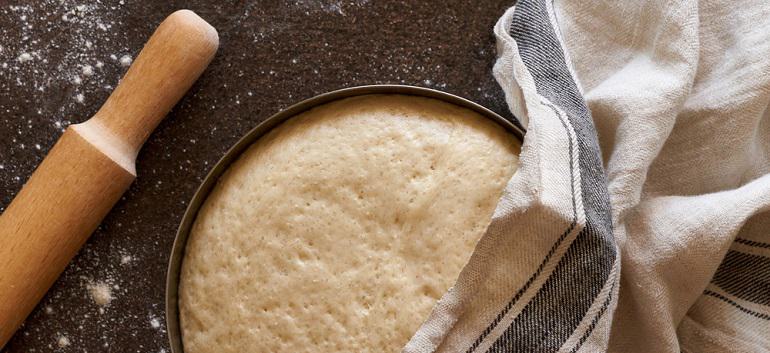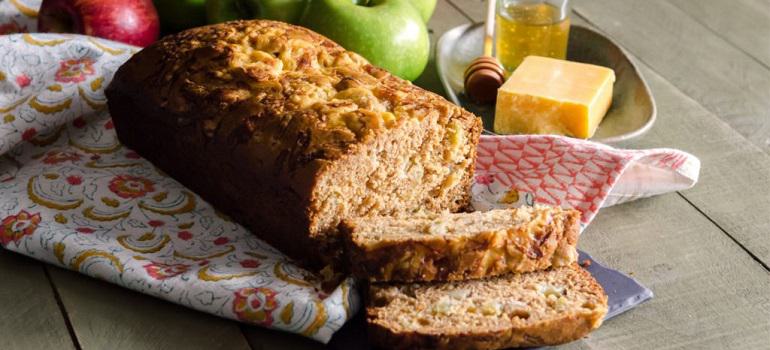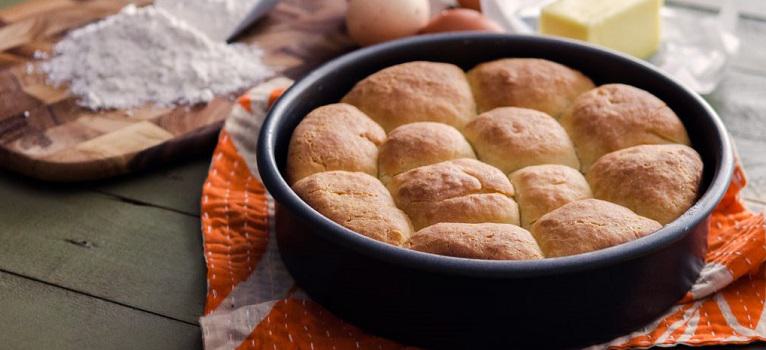If you're an avid baker, then the chances are you've worked with yeast before. Yeast is an essential ingredient in several bread and dessert recipes and an item that's kept stocked in nearly every baker's pantry. If, when working with yeast, you've questioned what it is, you're not alone. While many people know that yeast is a crucial element in their baked goods, very few know where it comes from. Curious to learn more about dry yeast, keep reading. This guide will cover how dry yeast is made and its most common uses.
Dry Yeast
We mentioned that dry yeast is a popular ingredient in modern baking, but what makes it so? Dry yeast is a pourable and granular powder made from millions of dehydrated unicellular organisms. When rehydrated, those same organisms feed off the sugar and starch found in dough recipes and produce alcohol and carbon dioxidea process that lends bread its light, airy rise, and distinct taste.
There are many methods for rehydrating yeast, and each recipe will require unique steps. When using dry yeast to create baked goods, following the recipe's instructions is crucial to produce the best result and ensure that the yeast thrives in the given environment.
What Is Dry Yeast?
 Dry yeast is a dehydrated form of baker's yeast. The dehydration process drastically extends its shelf-life and creates a product that no longer requires refrigeration. Dry yeast is used to create various baked goods and enhances the overall texture, rise and flavor. There are many different forms of dry yeast. However, two of the most common types found on grocery store shelves are active dry yeast and instant dry yeast.
Dry yeast is a dehydrated form of baker's yeast. The dehydration process drastically extends its shelf-life and creates a product that no longer requires refrigeration. Dry yeast is used to create various baked goods and enhances the overall texture, rise and flavor. There are many different forms of dry yeast. However, two of the most common types found on grocery store shelves are active dry yeast and instant dry yeast.
Active Dry Yeast
Active dry yeast is the most popular form of yeast used in hundreds of recipes. It's relatively easy to use, making it a favorite ingredient of novice and advanced bakers. Before use, active dry yeast requires a short rehydration time, in which it's mixed with a liquid before it's combined with dry ingredients.
Instant Dry Yeast
Unlike active dry yeast, instant dry yeast does not require proofing or rehydration. Instant dry yeast can be added directly to the flour mixture to produce an even rise and excellent texture.
Where Does Dried Yeast Come From?
Dried yeast has been around since WWII. Developed by Fleischmann during WWII, yeast allowed bakers to create breaded goods easily. While fresh yeast was the preferred ingredient when making bread, it had a short shelf life and required constant refrigeration. Dried yeast made it possible to store and carry yeast for more extended periods and packed double the fermentation power. After its development active dry yeast showed excellent potential for commercial baking operations and is now used for business and personal use to create flavorful baked goods.
How Yeast Works
 When added to doughs, yeast has several vital functions. Here are a few of the most notable:
When added to doughs, yeast has several vital functions. Here are a few of the most notable:
Helps Dough Rise Properly
Adding yeast to the dough helps promote carbon dioxide production, allowing the dough to rise correctly.
Promotes Acidification
The production of carbon dioxide reduces the pH levels of the dough, a process known as acidification which leads to a better tasting and textured bread.
Boosts Flavor and Aroma
When yeast is added to the dough, it starts the fermentation process. Additional flavor compounds are produced during fermentation, contributing to baked goods' overall flavor and smell.
Active Dry Yeast vs. Instant Dry Yeast
Earlier, we discussed the two most common types of dry yeast: Active vs. instant. Though made from the same thing, these types of yeast are used in different ways. To help you better understand when to use which, let's dive into each with more detail.
Active Dry Yeast
As the name suggests, active dry yeast must be "activated" before adding to dry ingredients. According to the recipe's instructions, this activation is done by dissolving the yeast granules in warm water, known as proofing. If the yeast is still alive, it will begin to foam and grow within minutes. Because active dry yeast is an unstable product, individual packets may be dead while others are still healthy, making it a good idea to proof the yeast before adding it to your recipe, even if it has yet to meet the expiration date. Aside from required proofing, active dry yeast is slightly larger than instant yeast and requires direct contact with warm water to dissolve.
Instant Dry Yeast
Instant dry yeast undergoes a much different manufacturing process than active dry yeast. Due to this unique process, instant dry yeast is guaranteed to be 100% active and can be added directly to dry ingredients. Instant dry yeast also has much smaller granules than other yeast types allowing it to more easily dissolve when combined with moisture-filled dough so that no rehydration is required. In addition, instant dry yeast's long shelf life makes it easy to purchase in bulk, reducing the overall cost compared to individual packets of active dry yeast.
When looking at the difference between active dry yeast and instant dry yeast, the main distinction is that active dry yeast must be dissolved in a liquid before being mixed with the other ingredients. In contrast, instant dry yeast can be mixed directly into the dough.
How to Use Dry Yeast
 Now that you know what dry yeast is, it's time to discover how you can use it to create tasty baked goods. Continue reading to find a few of our favorite recipes that feature dry yeast as the main ingredient.
Now that you know what dry yeast is, it's time to discover how you can use it to create tasty baked goods. Continue reading to find a few of our favorite recipes that feature dry yeast as the main ingredient.
To Make Bread
Not much is better than a freshly baked loaf of bread. If you're looking for a delicious homemade bread recipe, we recommend choosing one that features dry yeast. When added to the dough, dry yeast helps boost the flavor and texture of baked goods through carbon dioxide production. The carbon dioxide produces air bubbles trapped in the gluten during the fermentation process, causing the bread to rise and create a light and fluffy loaf. The next time you're itching to make homemade bread, opt for a recipe like this No-Knead Artisan Bread Recipe. This recipe is simple to make and perfect for first-time bakers and uses a slow fermentation method that produces a rich and textured loaf.
To Make Pizza Dough
No-knead bread isn't the only thing you can make with dry yeast. You can also make a light and flavorful pizza dough. The key to making the perfect pizza dough is creating a solid base to hold all of your favorite toppings. So whether you enjoy loading your pizza with veggies like bell peppers and mushrooms or crave something sweet and savory like pineapple topped pizza, you'll need a crust that can hold everything together.
There are a few different options when using dry yeast to create pizza dough. For traditional pizza dough, try out this Perfect Pizza Crust Recipe. Made with just four ingredientsActive Dry Yeast, warm water, Artisan Bread Flour and saltIt uses a delicious combination of whole food ingredients to create a thin yet sturdy dough that tastes great with anything.
Individuals with dietary restrictions, specifically those avoiding gluten, should make this Cassava Pizza Crust instead. This recipe offers the same rise and texture as traditional pizza dough sans gluten. It's delicious and good for you, and it's the perfect recipe to make when cooking for guests with food allergies.
To Create Dinner Rolls
[caption id="attachment_1176830" align="aligncenter" width="766"]

Homemade Buttermilk Rolls[/caption]
Dinner rolls make an excellent accompaniment to any dish. Whether you choose to set them out as an appetizer before the main course or serve them alongside a meal, they're the perfect way to ensure that everyone at the table remains satisfied and fed. Achieving the right texture is an essential part of creating a great-tasting dinner roll which makes dry yeast a crucial ingredient.
Whether you're searching for cheesy or herb-infused dinner rolls, we have the recipe for you. These Cheddar English Dinner Rolls are delicious, easy to make and are sure to win over the hearts and palettes of everyone at the table. Whereas these Easy Yeast Rolls with Butter and Thyme feature a lighter flavor that pairs well with sweet, savory and saucy foods.
Dry yeast has many uses in baking, and we hope that this guide has helped you discover more about this baking ingredient and how to use it. Whether you use dry yeast for baking up a homemade bread recipe or whip up a batch of dinner rolls, we're confident that the result will be delicious. From everyone at Bob's Red Mill, we wish you the best on your baking journey!
Do you enjoy baking with active dry yeast regularly? We'd love to hear about all of the tasty baked goods you create with this ingredient. Share your favorite recipes with us in the comments below.



 Dry yeast is a dehydrated form of baker's yeast. The dehydration process drastically extends its shelf-life and creates a product that no longer requires refrigeration. Dry yeast is used to create various baked goods and enhances the overall texture, rise and flavor. There are many different forms of dry yeast. However, two of the most common types found on grocery store shelves are active dry yeast and instant dry yeast.
Dry yeast is a dehydrated form of baker's yeast. The dehydration process drastically extends its shelf-life and creates a product that no longer requires refrigeration. Dry yeast is used to create various baked goods and enhances the overall texture, rise and flavor. There are many different forms of dry yeast. However, two of the most common types found on grocery store shelves are active dry yeast and instant dry yeast.
 When added to doughs, yeast has several vital functions. Here are a few of the most notable:
When added to doughs, yeast has several vital functions. Here are a few of the most notable:
 Now that you know what dry yeast is, it's time to discover how you can use it to create tasty baked goods. Continue reading to find a few of our favorite recipes that feature dry yeast as the main ingredient.
Now that you know what dry yeast is, it's time to discover how you can use it to create tasty baked goods. Continue reading to find a few of our favorite recipes that feature dry yeast as the main ingredient.
 Homemade Buttermilk Rolls[/caption]
Dinner rolls make an excellent accompaniment to any dish. Whether you choose to set them out as an appetizer before the main course or serve them alongside a meal, they're the perfect way to ensure that everyone at the table remains satisfied and fed. Achieving the right texture is an essential part of creating a great-tasting dinner roll which makes dry yeast a crucial ingredient.
Whether you're searching for cheesy or herb-infused dinner rolls, we have the recipe for you. These Cheddar English Dinner Rolls are delicious, easy to make and are sure to win over the hearts and palettes of everyone at the table. Whereas these Easy Yeast Rolls with Butter and Thyme feature a lighter flavor that pairs well with sweet, savory and saucy foods.
Dry yeast has many uses in baking, and we hope that this guide has helped you discover more about this baking ingredient and how to use it. Whether you use dry yeast for baking up a homemade bread recipe or whip up a batch of dinner rolls, we're confident that the result will be delicious. From everyone at Bob's Red Mill, we wish you the best on your baking journey!
Do you enjoy baking with active dry yeast regularly? We'd love to hear about all of the tasty baked goods you create with this ingredient. Share your favorite recipes with us in the comments below.
Homemade Buttermilk Rolls[/caption]
Dinner rolls make an excellent accompaniment to any dish. Whether you choose to set them out as an appetizer before the main course or serve them alongside a meal, they're the perfect way to ensure that everyone at the table remains satisfied and fed. Achieving the right texture is an essential part of creating a great-tasting dinner roll which makes dry yeast a crucial ingredient.
Whether you're searching for cheesy or herb-infused dinner rolls, we have the recipe for you. These Cheddar English Dinner Rolls are delicious, easy to make and are sure to win over the hearts and palettes of everyone at the table. Whereas these Easy Yeast Rolls with Butter and Thyme feature a lighter flavor that pairs well with sweet, savory and saucy foods.
Dry yeast has many uses in baking, and we hope that this guide has helped you discover more about this baking ingredient and how to use it. Whether you use dry yeast for baking up a homemade bread recipe or whip up a batch of dinner rolls, we're confident that the result will be delicious. From everyone at Bob's Red Mill, we wish you the best on your baking journey!
Do you enjoy baking with active dry yeast regularly? We'd love to hear about all of the tasty baked goods you create with this ingredient. Share your favorite recipes with us in the comments below.